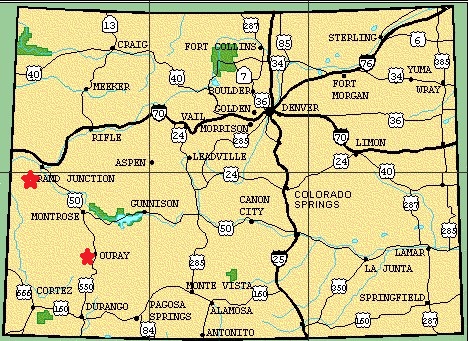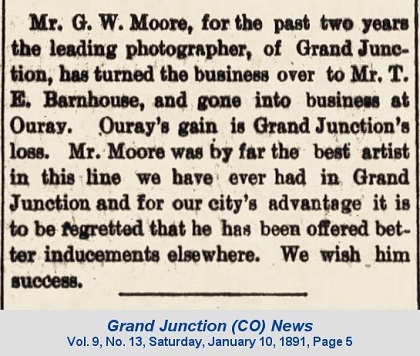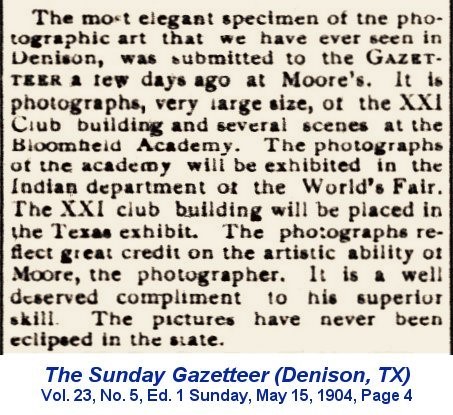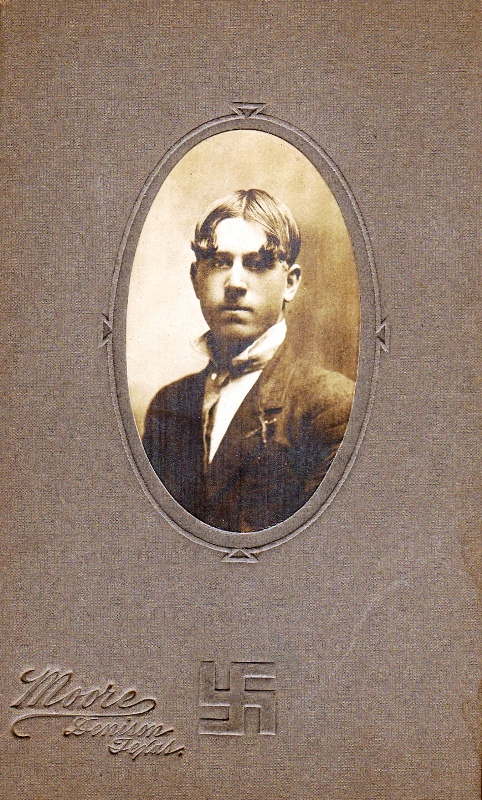|
George W. Moore 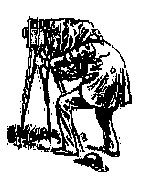 The
1900 and 1910 U.S. censuses provide our basic information,
indicating that this lifelong bachelor was born in January 1854 in
New York,
of parents born in New York also - Ira O.L. Moore (1810-1888) and Emma
Moore (1830-1907). George stated in 1908 that he had
been a photographer for 30 years, meaning that he began his career
around 1878. In the 1880 census George was living with his
parents in Medina, Orlean Co., New York; the father is a shoemaker and
George's occupation was listed as "photograph artist"; his younger
brother, David, was a clerk in a store. The
area of Grand Junction, Colorado was part of the former home
of Ute Indian Territory; the town incorporated in summer 1882
became known as Colorado Wine Country and was the death and burial
location of Doc Holliday in November 1887. G.W. Moore was living
and working in Grand Junction, Colorado for 2 years, ca1888 - January
1891. At the beginning of 1891 he left the town to
start his business in Ouray, Colorado, located about 100 miles south of
Grand Junction.
Haynes, citing Harber, Photographers and the Colorado Scene, 1853–1900 (Denver Public Library, 1961), places a photographer named "G.W. Moore", in Ouray, Colorado, in 1892–1893. Ouray was originally established by miners seeking gold and silver in the surrounding mountains beginning in 1877. The town was incorporated in in the fall of 1876 and named after Chief Ouray of the Utes. It is possible that Mr. Moore moved to the area about the time that the Denver & Rio Grande Railway arrived in the area in December 1887. The wanderlust may have been his motive for going out west as well as the prospects of a profitable businesss in the area. Moore's obituary in the Sherman Democrat stated that he came to Denison about 1893 from Colorado. George was first listed in the Denison, Texas City Directory for 1893-1894. That Sherman-Denison City Directory was being compiled by a corp of canvassers in April 1893 (The Sunday Gazetteer, Sunday, April 2, 1893). The new 1893-1894 Sherman-Denison-County businesses and farmers was delivered to patrons late July and early August 1893. This information about the various dates relevant to the City Directory, helps pinpoint George W. Moore's arrival in Denison no later than the spring of 1893 (The Sunday Gazetteer, August 6, 1893) George W. Moore was a fixture on Denison's Main Street for almost two decades. Around 1893, George W. Moore took over photographer John Swartz's space on the second floor at 210 West Main, and he lived and worked there until 1911. Living alone and lacking any known family support, Moore often took on helpers. The young Leona "Ona" Couchman served as his assistant from around 1896 until her untimely death on November 7, 1900 at the age of 27. Walter P. Lebrecht got early training in photography in Moore's Studio. The competition among studio photographers in downtown Denison was stiff. C.D. Ansley and the Snell Brothers were competent, personally popular, and well established in the community. Jack Hendricks, too, was around, trying out every type of camera he could find to record crowds, construction projects, and disasters. In the late 1890s, Moore advertised steadily in newspapers, high school yearbooks, city directories, and programs for special events. "There are lots of so-called photographers, that is that have picked it up, so to speak," said one 1898 ad in the Sunday Gazetteer. "Moore understands his business. He is the first in his line in Denison." The 1907 arrival of the "artist" Charles Hoffman, who touted his elegant settings and technical expertise, may have signaled the beginning of the end. However, Moore received high compliments of his artistic abilities in the local newspapers. In 1908, three years before Moore died in 1911, a promotional Denison business directory wrote: A photographer, like a poet, must be born, and though there are thousands of men who understand the mere mechanical phases of photographic art, there are really very few who can lay claim to the right of being styled the photographic artist. We have, however, a Mr. G.W. Moore, a gentleman whose very soul is in his work, and whose productions betray a masterly skill rarely seen in other photographers. He has had thirty years of practical experience [1878], for fifteen years has been established in Denison [1893], and may be said to stand at the very head of the profession in this city. His studio is beautifully fitted up with all the most modern apparatus, scenic settings and the finest of lenses. Here is executed everything in the way of high-class photographic work, and a large city and country patronage is enjoyed. Mr. Moore, while a gentleman of high talent as a photographer, is also successful as a business man. (“Denison, the Texas Gateway: A Busy, Progressive City with Golden Opportunities”) Moore made the photographs for a book by famed Denison horticulturalist, Thomas Volney Munson. Munson's Foundations of American Grape Culture was published in 1909 and remains a cornerstone of viticulture in the United States. Moore's exceptional talents were noted when some of his photographs were exhibited in the 1904 World's Fair in St. Louis, Missouri, which lasted seven months, May - November, 1904.
A Moore cabinet card photo sold on eBay in January 2009 featured the same woman in two different poses. She wrote on the back: "They are both me." In one pose she wore a black gown and stood facing the viewer, holding her gown outstretched. In the other pose, she wore a white dress and sat in a chair, appearing to be gazing at the first woman. Moore's portraits featured elaborate painted backdrops; several also employed fancy Victorian wicker or carved wooden chairs and settees. Ornate lace or brocade fabrics cushioned babies and children. Among those children photographed by Moore was an African American baby, C.A. Terrell. The Terrells were a respected Denison family. Augustus H. Terrell (1861–1929) was an educational, community, and church leader in the African American community. Terrell Elementary School was named in his honor. Moore
used more than one imprint; it should be possible to date his photos by
these different imprints. His cabinet cards had the imprint under the
photo, at the bottom of the card. Some, perhaps the oldest, were quite plain, with "Moore" on the left and "210 Main St., Denison, Texas" on the right. Others featured an artist's palette with brushes in the center, between "Moore" on the left and "210 Main St., Denison, Tex." on the right. Still other imprints, probably later, were printed in gold and had a circle with entwined initials G and W in the center, between "Moore" on the left and "Denison, Tex." on the right. Another group of photos, probably the most recent, have a dark grey mount impressed (not printed) with "Moore, Denison, Texas" on the lower left corner.
A few steps from George, at 216 West Main, was the jewelry store of Levi B. Moore (1837–1920). His ad in the 1896 City Directory featured a portrait, one of the few photographs in the book, in a round shape. In May 1906, Levi advertised himself thus: "L.B. Moore, Jeweler and Optician, Diamonds, Watches and Jewelry. Fine watch repairing a specialty. Inspector for MK&T and T&P Rys. 216 W. Main St. Eyes Tested Free." However convenient it might have been for a photographer and a movie theater to have a lens specialist nearby, no evidence indicates that the two Moores were related. Upstairs at 210, during all those years, a dentist, Henry T. Walker, occupied space across the hall from Moore. The 1900 Census indicated that a room on the long hall was taken by one Samual Sheets, single, white, age 46, born in Tennessee, his occupation being "operator." It is unclear what that term meant. Technicians who worked for photographers often called themselves "operators." However, since the nearby Western Union Telegraph office was headed by William C. Sheetz, who resided at 206-1/2 West Main, Samual may have been a telegraph operator. Living near William Sheetz at 206-1/2 West Main in April 1910 was Agnes Riddle, 27, a masseuse in a beauty parlor, and her eight-year-old daughter Gladys Riddle. Both were classed as "mulatto." Part Native American, Gladys Riddle (1902–1971) was born on a reservation in Lehigh, Oklahoma. The Riddles were part of an important African-American family in Denison. Gladys left Denison sometime before 1920 to attend Fisk University in Nashville. After graduation from Fisk, Gladys joined her mother in Los Angeles, where Agnes was running a boarding house, predominantly for railroad workers. Gladys, an expert seamstress from a young age, became a noted costumier (dress designer) for films in Hollywood. It is interesting to imagine the child Gladys in 1910 exploring the steep wooden stairway next door to her and Agnes's rooms on Main Street and perhaps watching George W. Moore arrange people and backdrops for portraits. What influence might such an early experience with photography have had on her imagination and her future life in Hollywood? When Moore passed away in Denison in March 1911, his studio was taken over by James Kape Jenkins, progenitor of one of the longest operating photography studios in Denison's history. Mr. Moore was buried in Fairview Cemetery, Denison, Texas.Mavis Anne Bryant. Lives in Photography: Denison, Texas, 1872- 1999 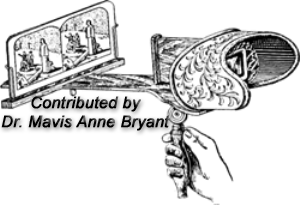 Denison History Biography Index Susan Hawkins © 2024 If you find any of Grayson County TXGenWeb links inoperable, please send me a message. |
